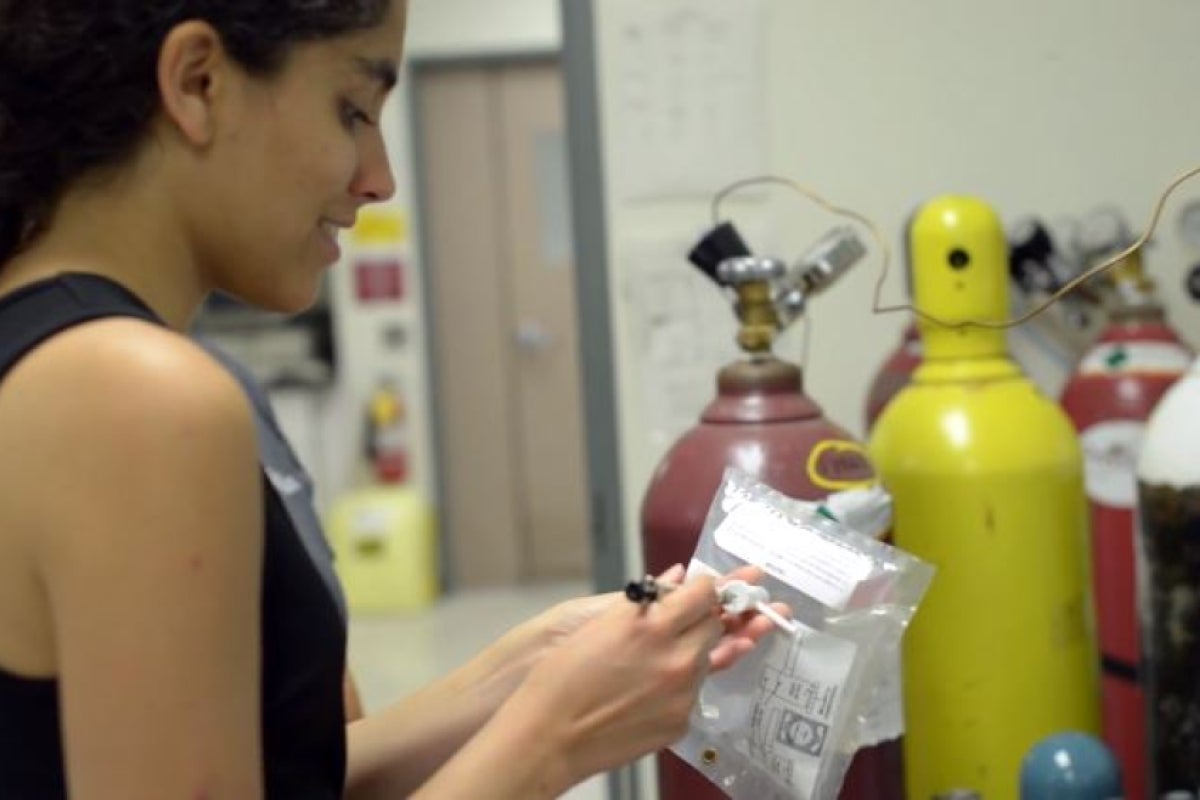Inspiring people to make better lifestyle choices — through isotopes

Amrita Rhoads and Gwyneth Gordon measure isotope ratios in a hair sample to estimate what participants typically ate. Photo courtesy ASU
Fitness goals are typically at the forefront of New Year’s resolutions for many Americans. A recent study from Arizona State University provides a new way to understand diet and exercise in a more holistic way that may help us reach those goals.
Geologist and isotope chemist Gwyneth Gordon, of the School of Earth and Space Exploration and the Office of Knowledge Enterprise Development, along with co-author and researcher Amrita Rhoads, recently completed a study using breath and hair to determine metabolism and increase of calories burned during exercise. The surprising results of their study have been published in the journal Isotopes in Environmental and Health Studies.
An interdisciplinary approach to metabolism studies
Gordon, who has a background in geology and isotopes, worked with researchers from both the ASU Biodesign Institute and the ASU School of Human Evolution and Social Change to develop various methods to measure metabolism rates for this research.
To conduct their study, Gordon and Rhoads recruited female participants who varied in age, body mass index, cultural affiliation, age and exercise history. For each participant, the researchers measured breath carbon isotopes before and after exercise to document metabolic increases with moderate exercise.
They then compared breath isotope measurements of metabolic increase with a smartphone-enabled indirect calorimeter called Breezing that was developed by Erica Forzani of the Biodesign Institute.
Participants also kept a log of what they were eating, which the researchers then compared to the analysis of their hair, providing baseline data about past eating habits. For the hair analysis, Gordon consulted with Kelly Knudson, of the School of Human Evolution and Social Change, who works on understanding human diet through hair isotopes.
“Hair isotopes are typically used to gain an understanding of lifestyles of archaeological populations,” Gordon explained. “but the same type of analysis can be used in modern populations as well.”
The results
Using these techniques, the researchers found that participants were burning fat when they woke up in the morning, since they had been fasting during sleep. Then, during exercise, they started burning more carbohydrates. This was found for all participants, regardless of what they had eaten.
“Initially, I had assumed that people would start burning fat during exercise,” Gordon said. “However, the data was showing the opposite of what we anticipated. The exercise we asked them to do was moderate — well within the U.S. Department of Health guidelines for physical activity — and it wasn't enough to burn through their carbohydrate stores.”
In the end, each participant was provided direct feedback about the impact of their exercise on their metabolism.
“This is a way to move metabolism research out of the academic laboratory into the life of the average person,” Gordon said.
Next steps
It is the hopes of Gordon and Rhoads that the results of this study will provide a new way to understand diet and exercise in a much more holistic fashion. They have combined techniques from geology, anthropology and cutting-edge sensors so that people can understand the impact of diet and exercise to manage weight.
People using the Breezing device can understand their personal metabolic response to exercise, and how it changes depending on intensity, type of exercise, recent diet and over the life course.
“This study represents a vision where people can have detailed information about how their lifestyle choices impact them, personally, in an objective way,” Gordon said. “This can inspire people to make better choices.”
The researchers also suggest that the analyses used in this study can help optimize all levels of athletic performance, from a middle-aged person who is working their way up to running a 5K to an Army recruit going through basic training.
“This kind of research doesn't require a big lab with a treadmill,” Gordon said. “Just a smartphone and a simple device.”
Co-author Rhoads, who is currently a bioengineering major at the California Institute of Technology in Pasadena, was a student at the Peggy Payne Academy at McClintock High School in Tempe when the research was conducted, and was involved in every aspect of the study. She helped write the grant proposal, conduct the research, analyze the data and write the research article for publication.
Gordon’s next steps are to pursue future funding to build on this research: “I think it's the type of use-inspired research that follows the mission and goals of ASU to work in collaboration with participants, to develop innovative global health solutions, and to work with our local community.”
This research was funded by a seed grant of the ASU-Mayo Foundation Obesity Solutions program with support from the Virginia G. Piper Charitable Trust.
More Science and technology

Diagnosing data corruption
You are in your doctor’s office for your annual physical and you notice the change. This year, your doctor no longer has your…
Large-scale study reveals true impact of ASU VR lab on science education
Students at Arizona State University love the Dreamscape Learn virtual reality biology experiences, and the intense engagement it…

ASU-led space telescope is ready to fly
The Star Planet Activity Research CubeSat, or SPARCS, a small space telescope that will monitor the flares and sunspot activity…





